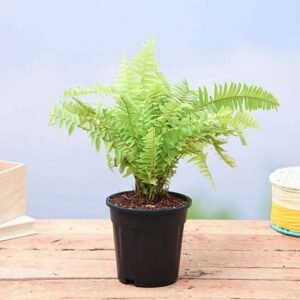Description
🌼 Hazari Mogra Plant (Jasminum sambac)
Overview:
The Hazari Mogra is a highly fragrant, evergreen flowering plant belonging to the jasmine family. Its name “Hazari” refers to the profuse blooming—often thousands of intensely aromatic white flowers. Widely cultivated in India and Southeast Asia, this plant is prized for its ornamental value, religious significance, and use in the perfume and cosmetic industries.
Botanical Information:
- Scientific Name: Jasminum sambac
- Common Names: Hazari Mogra, Arabian Jasmine, Mallika, Gundumalli
- Family: Oleaceae (Olive family)
- Plant Type: Perennial, evergreen shrub
- Growth Habit: Bushy, multi-branching
Physical Description:
- Height: Typically 1 – 1.5 meters; can be pruned for compact growth
- Leaves: Dark green, ovate, glossy, opposite arrangement
- Flowers: Pure white, double-layered (multi-petaled), intensely fragrant
- Blooming Season: March to November (peak in summer and monsoon)
- Lifespan: Long-living shrub, thrives for 8–10+ years with proper care
Cultivation & Care:
- Sunlight: Full sun to partial shade (minimum 4–6 hours of direct sunlight)
- Soil Type: Well-drained loamy or sandy soil, slightly acidic to neutral pH
- Watering: Moderate; avoid overwatering. Allow the topsoil to dry between waterings.
- Fertilization: Organic compost + balanced NPK every 30–40 days during growing season
- Pruning: Regular pruning after flowering enhances branching and bloom yield
- Spacing for Bulk Planting: 1.5–2 feet apart for optimal air circulation and flower production
Climate Suitability:
- Ideal Temperature: 20°C to 35°C
- Climate Zones: Tropical and subtropical
- Frost Sensitivity: Not frost-hardy – protect from freezing temperatures
Uses & Applications:
- Religious & Cultural Use: Widely used in temple offerings, weddings, and garland making
- Aromatherapy: Extracted oil used in perfumes, soaps, and skincare
- Ornamental: Popular in home gardens, borders, and pots
- Commercial Flower Trade: High demand in fresh flower markets and floral industries
Advantages for 1000-Plant Setup:
- High Yield: Each plant produces hundreds of flowers during peak bloom
- Low Maintenance: Hardy and adaptable with minimal pest issues
- Marketable: Excellent commercial potential in garland, perfume, and ornamental markets
- Propagation: Easily propagated through stem cuttings
Planting Guide for Plants:
| Item | Details |
|---|---|
| Total Area Required | Approx. 0.5–1 acre (depends on spacing) |
| Recommended Spacing | 1.5 ft (row to row) × 1.5 ft (plant to plant) |
| Irrigation System | Drip irrigation or sprinkler preferred |
| Maintenance Schedule | Monthly pruning and fertilization |
| Harvesting Method | Manual picking every 2–3 days during bloom |
Pest & Disease Management:
- Common Pests: Aphids, mealybugs, spider mites
- Diseases: Root rot (if overwatered), sooty mold (due to aphids)
- Preventive Measures: Neem oil spray, well-drained soil, regular inspection
Conclusion:
Cultivating 1000 Hazari Mogra plants offers a profitable and sustainable horticulture venture. With proper planning, care, and market access, growers can expect consistent income through fresh flower sales, essential oil extraction, and ornamental retail supply.






 ANANTA GANDRAJ/ GARDINIA - PLANT
ANANTA GANDRAJ/ GARDINIA - PLANT 

Reviews
There are no reviews yet.